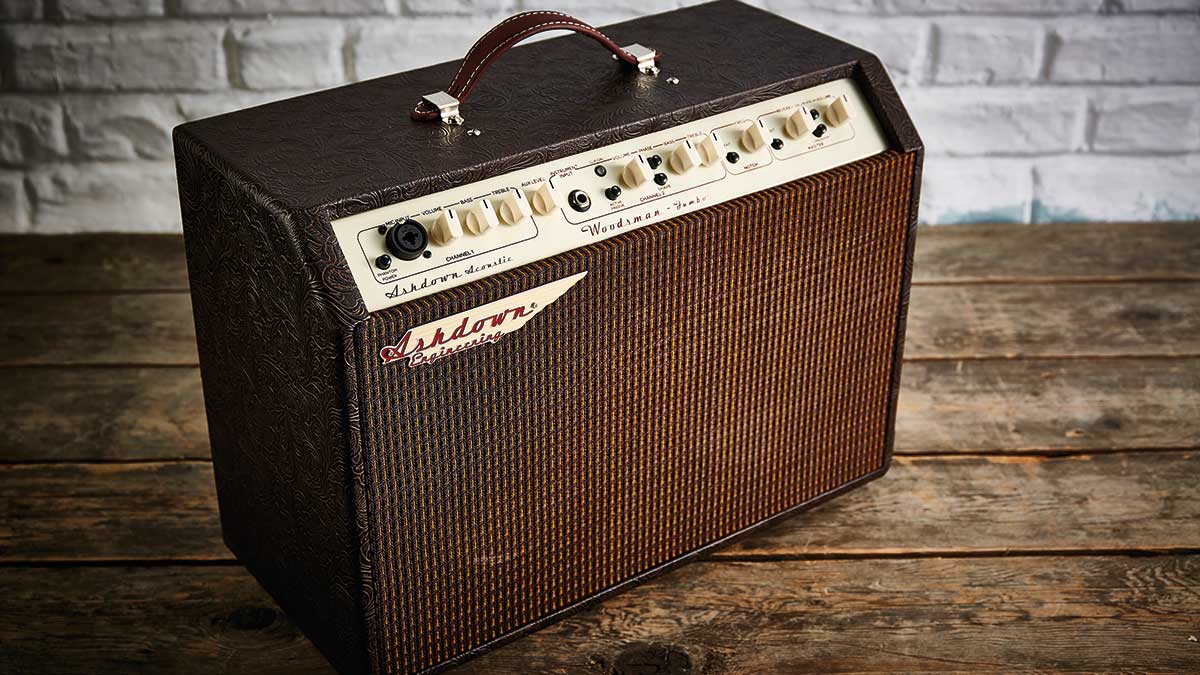MusicRadar Verdict
A solid performing acoustic amp that won't break the bank. Recommended!
Pros
- +
Well spec'd.
Cons
- -
Not a game changer.
MusicRadar's got your back
With a lineage that goes back to the originator of the genre - Trace Elliot's original Trace Acoustic - Ashdown's latest, three-strong UK-designed and Chinese-made Woodsman acoustic guitar amp range might change the aesthetic but it follows a pretty familiar format.
The range features the 25-watt Parlour (£149), 40-watt Classic (£279) and our reviewed 65-watt Jumbo.
The two-channel Jumbo, with 2x8 custom Celestion speakers plus a custom HF tweeter, is about the same size as a Vox AC10 combo - 326mm (h) by 468mm (w) by 225mm (d). It's covered with a folksy-patterned brown vinyl, the controls are cleanly laid out on the angled top panel, and there's a rustic-looking leather carry handle making for a lightweight (12kg), compact, easy-to-carry amp.
Channel one features an XLR/jack combi input that is designed for a mic input, with phantom power and simple volume, bass and treble rotary controls. Channel two has a standard jack input and is designed for your instrument's onboard pickup, with the same three rotary controls but added input level LED, active/passive push-switch, a phase switch and pre-set EQ shape switch.
Along with that, we get a notch filter with rotary frequency sweep control and in/out switch. The master section houses a digital reverb with two push switches for type (hall/plate) and decay (long/short), plus a single rotary for level and overall volume.
On the back is a standard jack line-level input for an mp3 player or other source with a level control on the front panel. The back panel also includes the mains lead input and illuminated on/off switch (which makes quite a 'clunk' turned on or off with the master volume up), as well as FX send and return jacks placed post EQ and pre the digital reverb, and an XLR DI output.
On the one hand, the Woodsman is a pretty simple affair, but aside from any actual midrange control, it's pretty nicely spec'd. Bass and treble do what they say: nicely balanced lows, not overdone (which you certainly don't want on stage), while the treble is crisp without sounding harsh or sterile - in fact, there's a subtle woody character here.
If the flat sound with the EQs centred is a little, well, flat-sounding, adding that preset EQ contour (to boost bass and treble with a slight mid-cut) is probably where you'd start with any steel-string. Aside from its duties, along with the phase switch to knock out feedback, the notch filter can be used as additional EQ, not least to thin out a little of the often cloudy lower mids.
The reverbs are great for general ambience, although you can't have different types or a different amount assigned to the two channels: it's a master effect. So, aside from more specific tweakery like that, as a general purpose, good-sounding acoustic amp or small-room mini PA (it's certainly room-filling) with enough features to sort feedback, the Jumbo ticks all the boxes.
There's now plenty of choice, both in specification and price, in the acoustic amp market, so why consider Ashdown? Well, while far from game-changing, it certainly wouldn't look out of place at home, it's light and compact, a very easy drive with enough features for most uses, is sensibly priced and sounds classy, either as a standalone unit or as an onstage monitor hooked up to a bigger rig.
Dave Burrluck is one of the world’s most experienced guitar journalists, who started writing back in the '80s for International Musician and Recording World, co-founded The Guitar Magazine and has been the Gear Reviews Editor of Guitarist magazine for the past two decades. Along the way, Dave has been the sole author of The PRS Guitar Book and The Player's Guide to Guitar Maintenance as well as contributing to numerous other books on the electric guitar. Dave is an active gigging and recording musician and still finds time to make, repair and mod guitars, not least for Guitarist’s The Mod Squad.

“The screaming was deafening!”: How a Japanese tour transformed the career of a weird little band known as the ‘Beatles of hard rock’

Ranked: Moog’s semi-modular ‘Mother’ synths from worst to best

“If it wasn’t for that song, that would have been the end of the band”: How one track’s sudden gear-switch led Coldplay into their imperial phase











